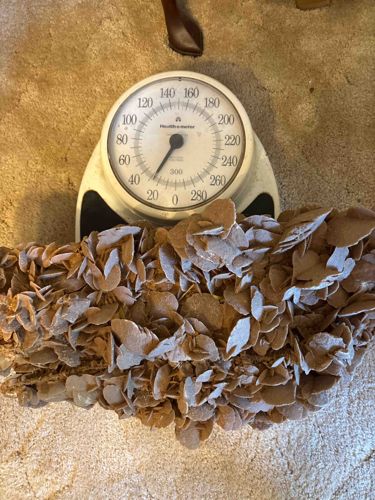
Large Selenite Desert Rose Cluster
This item is a substantial cluster of Selenite Desert Roses, characterized by its intricate, multi-layered formation resembling petrified rose blossoms. The overall color is a natural earthy tone, ranging from light brown to a reddish-brown, with some areas appearing lighter, almost grayish, potentially due to variations in mineral composition or surface dust. Physically, the cluster is quite large, stretching across a significant portion of the image, and its weight is considerable, as it appears to be placed on a 'Health-o-meter' scale which indicates a reading around 100-120 units (likely pounds or kilograms, making a substantial piece of rock). Each individual 'rose' formation is composed of numerous bladed or tabular gypsum crystals that have grown together in a radial fashion, creating the characteristic floral shape. The surfaces of these crystal blades appear somewhat granular and matte, without significant translucency typical of purer selenite, suggesting impurities like sand or clay incorporated during their formation in arid environments. No significant damage or repairs are visible from the provided image, indicating a relatively intact specimen. The natural formation of these Desert Roses is a testament to geological processes over time, making them a natural mineralogical specimen. The quality is indicative of a well-formed and large cluster, which is generally more desirable. The item's age is geological, forming over thousands to millions of years, while its 'manufacture' is purely natural.
AI-Generated Appraisal Disclaimer
Estimated Value
$800-1,200
Basic Information
Category
Mineral Specimen / Geode
Appraised On
December 1, 2025
Estimated Value
$800-1,200
Item Description
This item is a substantial cluster of Selenite Desert Roses, characterized by its intricate, multi-layered formation resembling petrified rose blossoms. The overall color is a natural earthy tone, ranging from light brown to a reddish-brown, with some areas appearing lighter, almost grayish, potentially due to variations in mineral composition or surface dust. Physically, the cluster is quite large, stretching across a significant portion of the image, and its weight is considerable, as it appears to be placed on a 'Health-o-meter' scale which indicates a reading around 100-120 units (likely pounds or kilograms, making a substantial piece of rock). Each individual 'rose' formation is composed of numerous bladed or tabular gypsum crystals that have grown together in a radial fashion, creating the characteristic floral shape. The surfaces of these crystal blades appear somewhat granular and matte, without significant translucency typical of purer selenite, suggesting impurities like sand or clay incorporated during their formation in arid environments. No significant damage or repairs are visible from the provided image, indicating a relatively intact specimen. The natural formation of these Desert Roses is a testament to geological processes over time, making them a natural mineralogical specimen. The quality is indicative of a well-formed and large cluster, which is generally more desirable. The item's age is geological, forming over thousands to millions of years, while its 'manufacture' is purely natural.
Get Your Items Appraised
Instant estimates of your treasures with AI-powered instant appraisals